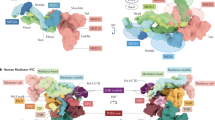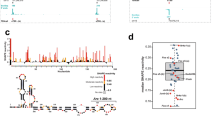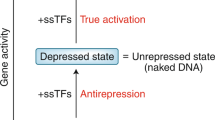Abstract
THE RNA polymerase II carboxy-terminal domain (CTD) consists of tandem repeats of the sequence Tyr-Ser-Pro-Thr-Ser-Pro-Ser1–3. The CTD may participate in activated transcription through interaction with a high-molecular-weight mediator complex4–6. Such a role would be consistent with observations that some genes are preferentially sensitive to CTD mutations7,8. Here we investigate the function of the mouse RNA polymerase CTD in enhancer-driven transcription. Transcription by a-amanitin-resistant CTD-deletion mutants was tested by transient transfection of tissue culture cells in the presence of α-amanitin in order to inhibit endogenous RNA polymerase II. Removal of most of the CTD abolishes transcriptional activation by all enhancers tested, whereas transcription from promoters driven by Spl, a factor that typically activates housekeeping genes from positions proximal to the initiation sites, is not affected. These findings show that the CTD is essential in mediating 'enhancer'-type activation of mammalian transcription.
This is a preview of subscription content, access via your institution
Access options
Subscribe to this journal
Receive 51 print issues and online access
$199.00 per year
only $3.90 per issue
Buy this article
- Purchase on Springer Link
- Instant access to full article PDF
Prices may be subject to local taxes which are calculated during checkout
Similar content being viewed by others
References
Corden, J. L., Cadena, D. L., Ahearn, J. Jr & Dahmus, M. E. Proc. natn. Acad. Sci. U.S.A. 82, 7934–7938 (1985).
Allison, L. A., Moyle, M., Shales, M. & Ingles, C. J. Cell 42, 599–610 (1985).
Corden, J. L. & Ingles, C. J., in Transcriptional Regulation (eds McKnight, S. L. & Yamamoto, K. R.) 81–108 (Cold Spring Harbor Laboratory Press, Plainview, New York, 1992).
Thompson, C. M., Koleske, A. J., Chao, D. M. & Young, R. A. Cell 73, 1361–1375 (1993).
Kim, Y. J., Bjorklund, S., Li, Y., Sayre, M. H. & Kornberg, R. D. Cell 77, 599–608 (1994).
Koleske, A. J. & Young, R. A. Nature 368, 466–469 (1994).
Allison, L. A. & Ingles, C. J. Proc. natn. Acad. Sci. U.S.A. 86, 2794–2798 (1989).
Scafe, C. et al. Nature 347, 491–494 (1990).
Bartolomei, M. S. & Corden, J. L. Molec. cell Biol. 7, 586–594 (1987).
Müller-Storm, H. P., Sogo, J. M. & Schaffner, W. Cell 58, 767–777 (1989).
Zehring, W. A. & Greenleaf, A. L. J. biol. Chem. 265, 8351–8353 (1990).
Buratowski, S. & Sharp, P. A. Molec. cell. Biol. 10, 5562–5564 (1990).
Bartolomei, M. S., Halden, N. F., Cullen, C. R. & Corden, J. L. Molec. cell. Biol. 8, 330–339 (1988).
Gerber, H. P., Georgiev, O., Harshman, K. & Schaffner, W. Nucleic Acids Res. 20, 5855–5856 (1992).
Gill, G., Pascal, E., Tseng, Z. H. & Tjian, R. Proc. natn. Acad. Sci. U.S.A. 91, 192–196 (1994).
Guarente, L. Cell 36, 799–800 (1984).
Banerji, J., Rusconi, S. & Schaffner, W. Cell 27, 299–308 (1981).
Moreau, P. et al. Nucleic Acids Res. 9, 6047–6068 (1981).
Seipel, K., Georgiev, O. & Schaffner, W. EMBO J. 11, 4961–4968 (1992).
Rusconi, S., Severne, Y., Georgiev, O., Galli, I. & Wieland, S. Gene 89, 211–221 (1990).
Towbin, H., Staehelin, T. & Gordon, J. Proc. natn. Acad. Sci. U.S.A. 76, 4350–4354 (1979).
Westin, G., Gerster, T., Mueller, M. M., Schaffner, G. & Schaffner, W. Nucleic Acids Res. 15, 6787–6798 (1987).
Radtke, F. et al. EMBO J. 12, 1355–1362 (1993).
Schatt, M. D., Rusconi, S. & Schaffner, W. EMBO J. 9, 481–487 (1990).
Wieland, S., Gail, I., Schatt, M., Severne, Y. & Rusconi, S. in Activation of Hormone and Growth Factor Receptors (eds Sekeris, C. E. & Alexis, M.) 215–225 (Kluwer Academic, Dordrecht, 1990).
Seipel, K., Georgiev, O. & Schaffner, W. EMBO J. 11, 4961–4968 (1992).
Severne, Y., Wieland, S., Schaffner, W. & Rusconi, S. EMBO J. 7, 2503–2508 (1988).
Banerji, J., Olson, L. & Schaffner, W. Cell 33, 729–740 (1983).
Muller M. M., Ruppert, S., Schaffner, W. & Mathias, P. Nature 336, 544–551 (1988).
Author information
Authors and Affiliations
Rights and permissions
About this article
Cite this article
Gerber, HP., Hagmann, M., Seipel, K. et al. RNA polymerase II C-terminal domain required for enhancer-driven transcription. Nature 374, 660–662 (1995). https://doi.org/10.1038/374660a0
Received:
Accepted:
Issue Date:
DOI: https://doi.org/10.1038/374660a0
This article is cited by
-
Disordered C-terminal domain drives spatiotemporal confinement of RNAPII to enhance search for chromatin targets
Nature Cell Biology (2024)
-
Determinants of transcription factor regulatory range
Nature Communications (2020)
-
RNA polymerase II clustering through carboxy-terminal domain phase separation
Nature Structural & Molecular Biology (2018)
-
Specific threonine-4 phosphorylation and function of RNA polymerase II CTD during M phase progression
Scientific Reports (2016)
-
Evolution of lysine acetylation in the RNA polymerase II C-terminal domain
BMC Evolutionary Biology (2015)
Comments
By submitting a comment you agree to abide by our Terms and Community Guidelines. If you find something abusive or that does not comply with our terms or guidelines please flag it as inappropriate.



